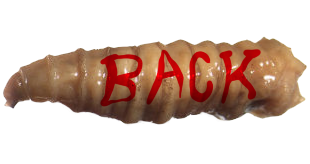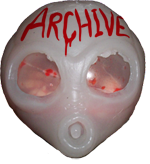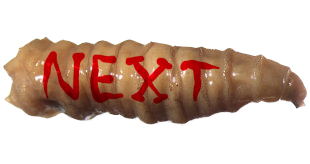
Halloween 2024: My Top Five Speculative Vampire Animals
Written by Jonathan Wojcik

Recently I talked about how charmed I am by all those
nasty little animals in our world that subsist strictly on blood, why exactly that might be, and why maybe you should too. I also talked about how much I love to come up with
just awful speculative animals. Today, these worlds collide! It's the "vampire" animals I'd be keenest to unleash upon all of you if some fool had ever let me design our planet's wildlife!
The Sandked

I've talked at length about having an
extra special affection for Hippoboscids, or "louseflies," none of which particularly target us humans as their drinking fountains, but may specialize in a variety of hoofed mammals, certain birds and most especially bats. This is probably why not that many people are all that familiar with them outside entomology, sheep husbandry and maybe deer hunting, and frankly I would have liked an opportunity to remedy that.
The sandked is my proposal for a bigger, bolder, more "in-your-face" lousefly. I'm merciful enough that I would not imbue this creature with any communicable diseases, I wouldn't give it the capability to colonize your house, I wouldn't put humans all that high on its list of favorite meals, and I wouldn't even make it anywhere near as ubiquitous as ticks or mosquitoes. I would, however, let it be
just common enough,
juuust opportunistic enough, that perhaps it might join chiggers, skunks, poison oak and Yogi Bear in making the occasional camping trip just a little bit more miserable.
This would be a
quite large insect, comparable to some of the bigger horseflies out there. Where I grew up in Maryland, we even had one of those that rivaled hornets and cicadas in size! The sandked would compensate for a lack of wings by being highly mobile on its legs, a quick runner and excellent climber, as well as a decent burrower in loose, dry sand or soil, hence the name. Burying itself by day, it would follow a "vampire bat" strategy by emerging at night to hunt down and feed from slumbering, warm-blooded vertebrates, probably following the migrations of herd animals. Like many hippoboscids, it would actually gestate larvae internally and "give birth" to pupae that hatch almost immediately into new adults, but unlike most flies or indeed many other insects, it would produce only a small number of offspring over the course of a fairly lengthy two or three year lifespan.
As with vampire bats, you would rarely find yourself in a situation to be bitten by a sandked, seeing as you'd have to be asleep or otherwise lying motionless after dark in sandked land with no suitable protection. But it would obviously still happen, certainly, and those bites might just hurt like the dickens, considering how large it is. It wouldn't be dangerous to any degree, no, but people would
really really not like that they exist, no.
CULTURAL IMPACT: if such a large, weird, scuzzy bug existed and sometimes deliberately bit people, there's no way society could resist it as any number of ongoing memes. Considering the fact that they would surely pester domestic livestock, and much more "visibly" than the usual little flies and gnats, perhaps "barnyard" settings in media would commonly toss in a sandked character in much the same way that cartoons about dogs will inevitably feature a personified flea or two. Maybe a sandked would inspire a nice bug/dark or bug/poison Pokemon by at least the third or fourth generation, and perhaps they'd find a place in Halloween imagery alongside spiders and bats? Then again, I did give them an affinity for sand and cattle, and we don't often mix things iconic to "the desert" with Halloween, do we? We seldom frame a cactus as an inherently spooky symbol, for example, despite the fact that it is objectively a scarier vegetable than a pumpkin. In that case, maybe the sandked would earn itself a "Wild West" association, like rattlesnakes and tumbleweeds, and in
that case, I think we all know at least one Tokusatsu series would feature a sandked monster who's also an evil cowboy.
The Bloodslug

We've discussed previously that blood-feeding gastropods already exist, but unfortunately, all of them are strictly marine. I think this is a very rude thing for the ocean to have done, having already hoarded all the Cephalopods, Cirripedes, Corals, Siphonophores and Nudibranchs to itself, to name just a
few of the exclusively saltwater taxa.
Pure greed on saltwater's part.
Maybe there's a reason why no terrestrial Gastropoda have evolved to feed predominantly on blood, considering there's so many other ripe and ready food sources for a slow-moving mollusk up here on the dirt, but
exclusively carnivorous land-slugs and land-snails are abundant enough, even if they almost all just feed on things like earthworms and other, smaller mollusks, but there are also plenty of bloodsuckers we went over that aren't particularly mobile, either, or are able to wait a good long while between meals.
Let's say the bloodslug hatches from its egg
extremely tiny. A barely noticeable speck of goo. Once it crawls into the fur of a sleeping vertebrate, it drills a nice long, proboscis-like radula into the host's flesh and stays there for a few days, maybe even weeks. Maybe it's not even a slug at this stage, either, but has a smooth and flat shell it can hide under, like a limpet, sealing in moisture and holding flush to the host's skin. After this extended period of ectoparasitism it drops off, only to feed again days later for a reduced period of time. The larger it grows, the shorter its feeding sessions, until finally it only feeds for a few hours at a time, sometimes months apart, and it's as big as a fat, happy banana slug, with only a vestige of its old shell. Why this particular growth pattern? This cycle of attaching, feeding and detaching again is common to many ectoparasites, the tried and true "bed bug model" that increases the odds of being passed from one host to another and dropped off in new locations. Losing their shells allows the adults to hide their soft bodies in crevices when they aren't feeding, and giving up their method of travel means adults will collect long-term in the same viable feeding grounds, where they can make lots and
lots of eggs.
CULTURAL IMPACT: bloodslugs wouldn't easily spread among humans, but you never know if a few babies might decide to hop off a raccoon or opossum on your own back porch, or even a mouse in your own home, and start developing on you or your pets while you barely even notice. It would be fairly rare that they could reach maturity in the harsh conditions of the modern human lifestyle, but even one person waking up to a big, fat slug slurping off their veins, or the combination of an itchy welt and a
slime trail, would quickly cement them in the public consciousness. If they have a distinct enough look to them, perhaps a tell-tale color pattern, there's no doubt
these would become one of our go-to "spooky" animals, and maybe they would have already inspired mythological creatures the world over. Would we think of vampires as transforming into them, or at least having them as pets and minions? There can be no doubt that "giant" bloodslugs would be the subject of more than one monster movie, and perhaps a famous staple of fantasy gaming bestiaries.
The Ghost Frog

A
frog that can suck blood is probably the second most far-fetched concept I'm going to posit here, considering that every single frog, and in fact every single amphibian ever discovered anywhere in the world at any point in the fossil record, shares the same identical feeding strategy of cramming any other creature into their mouth that the amphibian believes should be able to fit in its mouth. The evolutionary adventure that ends in carefully extracting some of the juices from a buffalo or a chicken are circumstantial enough that it's only happened once or twice to terrestrial vertebrate life
at all, and frogs are seldom even graced with any sharp bits to work with.
But let's pretend that it
did happen, somehow. Somehow, some way, it was more viable for a froggy to figure out how it can tap into a circulatory system than go on hunting everyday bugs and worms. Some
pretty weird things have certainly emerged in them before, like the frogs whose tadpoles morph into a flesh-eating form just to cannibalize their own siblings. Maybe a tadpole that lives just like a lamprey wouldn't be far off from that one, given that plenty of tadpoles also have powerful sucker-like mouths for clinging to smooth surfaces and scraping algae from river rocks? But we're talking about
grown-up frogs, here! Not little baby pollywogs! Lucky for us, there are even a few frogs that did evolve ways to cut things. A few species have makeshift "teeth," actually sharp and pointed projections of the jawbone itself. There's the bizarre "hairy frog" that breaks its own fingers to claw its rivals with its own shattered bones. And then there's the frog that's both poisonous
and "venomous," because it stabs its attackers with a sharp dagger-like face, forcing its own toxic skin secretions into the wound! The numbing and anticoagulating compounds of sanguivores are thought to have evolved from what was once plain old deadly venom, or at least emerged very similarly to traditional venom.
Let's imagine a little "tree frog" here, nimble and sucker-toed and great at getting around, even pretty far from bodies of water. I used to live in Florida, and those invasive Cuban tree frogs were just
everywhere, even in the drier summers! Heck, they even got into houses quite a bit, where they were often welcome to eat their fill of the equally ubiquitous plethora of cockroaches. They might not be so welcome, however, if they had a thirst for people's life essence, anaesthetic slime and natural surgical scalpels on their heads. Their skulls, not their jaws, would terminate in their weapon of choice, just like those venomous guys, but in this case it could taper into a beaklike hook the frog could employ, like the fangs of our friend Vampire Bat, to pick open a tiny little hole in your skin and start lapping up your secret sauce. As for their physical appearance, it's tempting to give them the spooky transparency of a glass frog, but that feels too "on the nose" for my taste. I still don't want them to look like just any old frog with a beak, however, so how about we make this one a dead leaf mimic, ranging from a bright yellow to a black and brown?
CULTURAL IMPACT: the combination of slimy amphibian, rotten leaf disguise and vampirism wouldn't just slam-dunk this animal into every spooky-tinted subculture, but maybe we would find it distinctive enough that we
wouldn't even call it a frog, but something else entirely, in much the same way we decided (rather arbitrarily, from a biological perspective) that some frogs are instead to be known as "toads." Or that the weirder groups of lizards get special designations like
gecko and
chameleon. What name would we give this thing, then? I'd like to think, just like "frog" and "toad," it would be an original word all its own. Just a weird noise, basically, like "glink" or "vetch." Actually, I like vetch. It's already the common name of one group of plants, but that's okay. It can be both things, or in this hypothetical alternate timeline, a devilish little Anuran might have claimed it first. Do you think a Vetch would sneak into any amphibian-centric media, if it had always existed? Would kids read
Frog and Toad and Vetch, in which best friends Frog and Toad do their best to avoid their kind of creepy neighbor? Would Kermit have a skeevier distant cousin who shows up for Halloween specials?
Regrettably, there's one possible downside here in that the very existence of the vetch might actually damage the cultural image of its fellow Amphibia. There's people out there terrified of everything spider-shaped no matter the danger level, people who not only hate rats but even hate opossums for being incidentally rat-shaped, and I
swear I used to encounter grown adults who assumed that any kind of bat, in any kind of country, could in fact be the vampire kind, which they also assumed would just swoop down on any unsuspecting human and attack them where they stood. I haven't heard that one since I was a kid in the 80's, but to this day, I've still heard dumber, too. Maybe it would still all be worth it to live in the world with the Vetches in it, though.
You and I would have always loved them anyway.
The Mudsticker

One of my favorite animal groups in all the world is also easily one of the most surreal, distorted predatory vertebrates evolution ever concocted, and yet, for some reason, it also has a cute, wholesome, completely saccharine cultural image. SEAHORSES however are NOT just a cute shape for pastel bathroom decor! Have you LOOKED at a seahorse? Have you thought about how that is a
fish? What the hell
happened to that fish?? A seahorse looks like someone left a lizard fetus lying in the sun for too long. Evolution broke its bones and mangled its flesh into exactly the shape of something that isn't any sort of fish, all because it took to just hooking itself onto objects and waiting for food to drift in front of it, which is any other animal tiny enough to slurp into its tube-shaped skull. POSITIVELY beautiful and enchanting, yes, but a beautiful and enchanting
monstrosity if there ever was one.
I think seahorses could use an injection of extra edge, even if it means creating a seahorse that we might only loosely recognize as such. The mudsticker would be
freshwater, for one, mostly so more people would get to experience its charms up-close and also so it would be easier for me to keep in an aquarium. Living a lot like a leech, it would dwell in lakes, ponds and swamps where it would cling to submerged objects and wait for something edible to brush by, snapping shut its wickedly fanged, teeny-tiny little mouth and bloating itself with enough blood to last its slow metabolism a year, if need be, which in case you missed me saying so is also a capability of leeches, while some species of tick can apparently last
decades without food. Seahorses are also already rather spiny animals, but the mudsticker would be the prickliest by far; a necessary defense for a seahorse so much more exposed to hungry wading birds. Perhaps their spines would even be sharp enough that they easily grip passing objects in the same manner as some "hitch-hiking" plant seeds? I just always found those really fascinating in action, how easily they "stick" at the lightest touch. Getting rather easily caught up in duck feathers or lodged under turtle shells would also give them an easy transportation system, allowing the pests to turn up in even the most remote little marshes and stagnating ponds, which would be another thing: leeches are pretty sensitive about water quality, but with their tougher, less permeable hides,
these aquatic bloodsuckers could adapt to some pretty foul conditions. Unappetizing to most predators, resistant to pollution and slow-growing, they could build up pretty densely over time and be
misery to accidentally step in, but maybe that just serves you right, tromping around like that in what's equally likely to be a sensitive wetland habitat or a pit of sewage runoff. There are very different reasons why you don't belong in either of those!
CULTURAL IMPACT: these would look just different enough from "seahorses" that they probably wouldn't have any impact on one another's reputation. Maybe some people wouldn't even connect that they belong to the same group, and it would be a source of zoological "trivia" or a "fun fact" to point out that those
nasty, thorny fish-leech things are actually a very messed up freshwater seahorse. Otherwise, perhaps we would just think of the two as interesting counterparts; lovely, cheerful sea-friends vs. creepy, wretched swamp-vermin. We
love our light and dark dichotomies. Every time we gave an ocean-themed hero a seahorse mount, we would just have to give their rival villain a gnarly giant mudsticker to ride around on, even if any biology nerd would be quick to point out that those are
not a saltwater animal, so the two would never be able to fight each other in the same environment. Absurd!
The Vampire "Butterfly"

I talked about this one once on tumblr, at some point, but even moreso than seahorses, butterflies have
far too innocent an image. The reality is that they can be surprisingly brutal creatures and come with some
exceedingly freaky adaptations, like genitals equipped with rudimentary eyesight. They also
already exhibit a taste for blood, though they also enjoy feces, urine and basically any other pungent body fluids they can find. We just don't tend to see this often enough for it to have ever shattered their wholesome position in our world view, and they don't do anything to obtain those body fluids for themselves, like their vampire hawkmoth cousins. It's worth mentioning, of course, that "butterfly" and "moth" are taxonomically meaningless distinctions anyway; butterflies are just a small group of moths who trend towards diurnal activity cycles as well as bright colors, and they aren't even the only moths who can boast all that. So, technically speaking, a vampire butterfly would just be a different kind of vampire moth, which we already have and I should already be happy and content with, but I'm sure you get what I mean. A vampire moth with huge, bright wings that flutters around in broad daylight, just like the "butterflies" everyone treats as just
sooOOOOooo romantic and delightful, not like, say, those
mean and evil wasps, who it should be stated are sometimes the only thing standing between the ravenous larvae of butterflies and the utter decimation of local plant life.
To be fair though, I'd want this edgier butterfly to still have a distinctive appearance. A combination of wing shape and color scheme that can't be easily mistaken for any other species. Having looked again at a few butterfly taxa, there are some with largely transparent wings, and there are some with convincing owl-like eyespots we more often associate with moths, even some with
multiple false eyes per wing, so how about
crystal clear wings, except for all the eyespots? A collection of eyeballs flapping through the air. Maybe that's too conveniently rad to combine with draining blood, like the notion of a vampire frog with a visible skeleton, but first of all it's MY butterfly, and second, the death's head moth not only has a scary skull right on it, but it steals honey for a living and sometimes its caterpillars are raised on nightshade.
CULTURAL IMPACT: I think this would be a
huge one. Butterflies are already everywhere in our iconography, on doilies and stickers and jewelry and postcards and just wherever you feel like putting something everyone likes to agree is "pretty," like a flower or a seashell or a snowflake. But what happens when we all know there's a "bad girl" butterfly out there, and we all know what it looks like? As long as it has that unique, recognizably unsettling wing pattern, you'll always know when the artist meant to say that this isn't the sunshine and cuddles kind of butterfly, but a butterfly tailor-made to juxtapose with images of bleeding roses and sexy vampires.
The Strix

-
-------
So just what is the unique appeal of all this creatures, for me personally? We've talked about their ecological value and technically "kinder" brand of predation, but my own fascination with nature's hemophiliacs definitely began before I could really appreciate them from that complex ecological angle. If I have to psychoanalyze myself, I'm sure I've admitted before that I'm more squeamish about bleeding than you probably expect from either a grown man or horror fan, and that when I was just a teeny little child, that "squeamishness" was closer to a panic-inducing phobia. A speck of blood, so much as a single tiny red dot of it in a cartoon drawing, had me screaming bloody murder as surely as if I walked in on literal bloody murder. I still don't know why that was ever the case, but I certainly wasn't immune to the allure of those mighty, murderous meat-eaters I was just on about, so maybe my developing brain slotted those sleazy, spineless sanguivores into the same column because both of them were, to my mind at the time, equally terrifying?
On the other hand, it was never any more difficult for me to see something lovable in traditionally adorable herbivores, either, or the very plants they eat, or fungi, or protists, or literally just anything at all that's alive. The fact that living things come in all of these categories, with all kinds of wacky body parts and behavioral patterns to facilitate these lifestyles, has always and continues to just thrill me to bits. Maybe I just have a special love of the vampires and parasites because so much of our society doesn't see them as just as another charming flavor of woodland critter? Maybe their image as ghoulish and disgusting gives them an "underdog" appeal to me, the same way I might feel for a tiny dog nobody wants just because it bites and it stinks and always looks like it just rolled in its own barf even in those rare times that it hasn't. That is an objectively unpleasant dog, but doesn't the thought tug at your heart a little, anyway?
Maybe it's also that I do see what's so "unwholesome" about these creatures, but that's also its own special kind of entertainment, like the fictional character you can't help but love for their unapologetically toxic characteristics. That guy (or far too rarely, gal) in that anime or webcomic or video game whose entertainment value overshadows every other character entirely because they're a lying, cheating, pathetic, slovenly scumbag you would never actually want to touch without gloves on.
I guess it might really be all of the above, for me. If nature is a cast of characters, natural "vampires" from moths to finches are all at once sort of like gothic monsters, sympathetic rejects, conniving sleazes and misunderstood antiheroes.
WAYS YOU CAN SUPPORT THIS SITE!

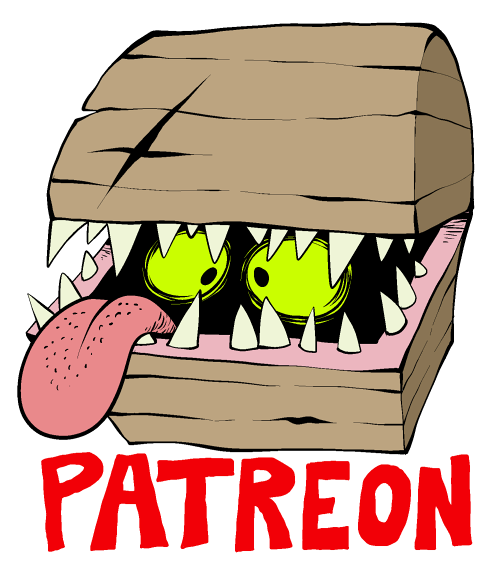
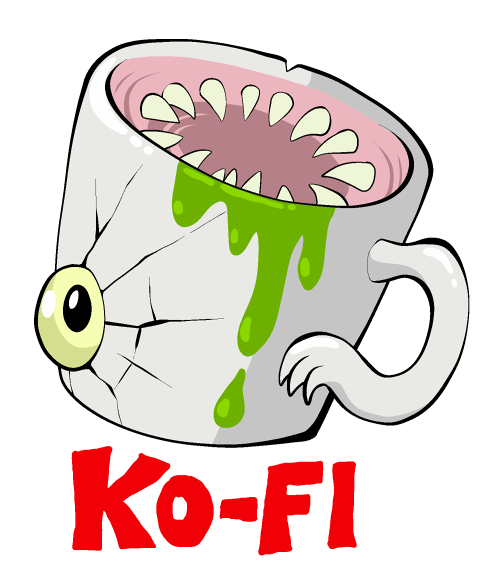
MORE HALLOWEEN FEATURES:
